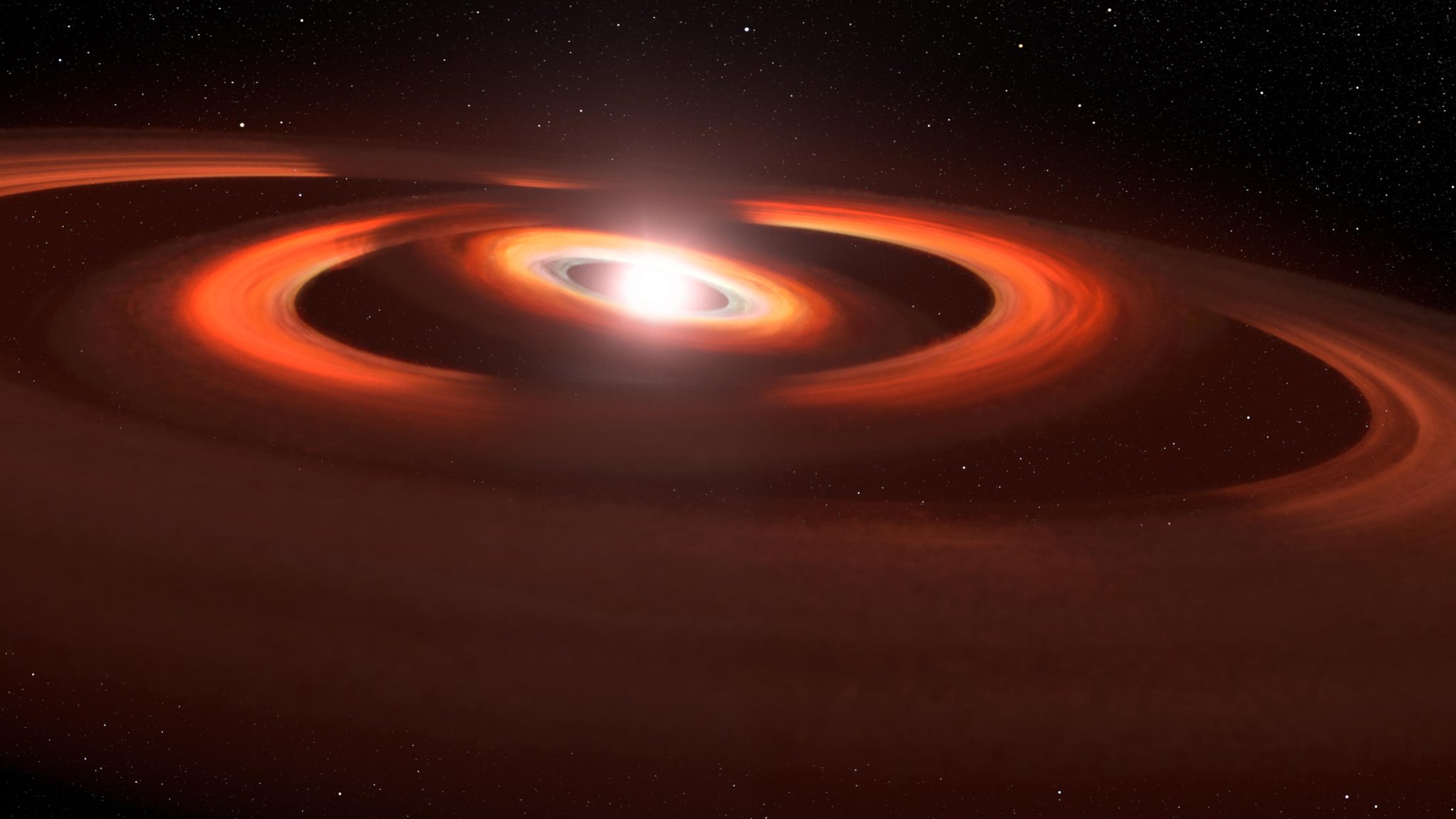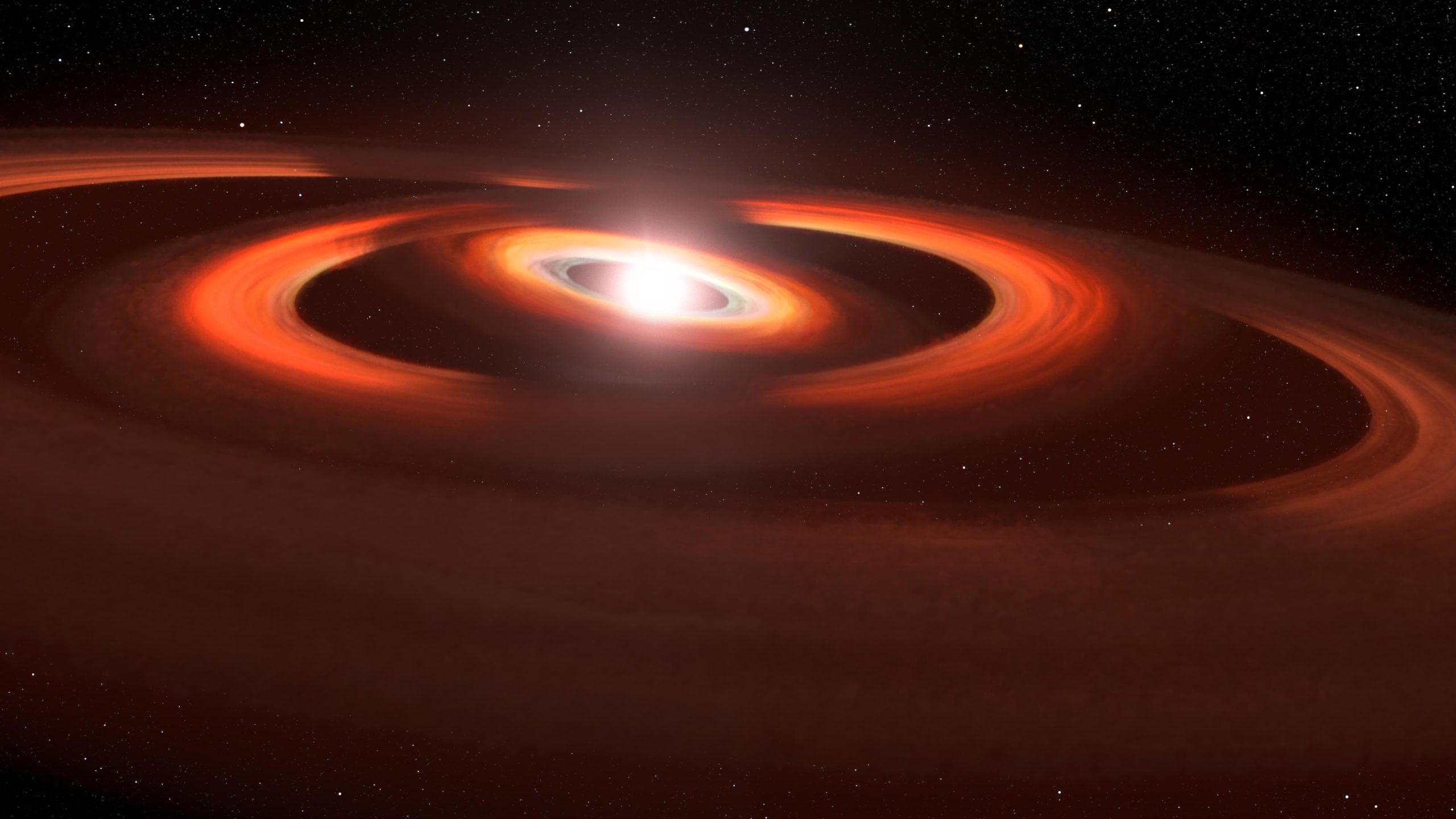
O conceito deste artista é baseado em imagens do Telescópio Espacial Hubble de discos de gás e poeira ao redor da jovem estrela TW Hydrae. As imagens do Telescópio Espacial Hubble mostram sombras envolvendo os discos que cercam o sistema. A explicação é que essas sombras vêm de discos internos ligeiramente inclinados que impedem que a luz das estrelas alcance o disco externo, projetando assim uma sombra. Os discos são ligeiramente inclinados um em direção ao outro devido à força gravitacional dos planetas invisíveis que distorcem a estrutura do disco. Crédito: NASA, Aura/STScI, Agência Espacial Europeia, Leah Hostack (STScI)
Planetas recém-nascidos invisíveis levantam poeira ao redor de uma estrela jovem
Nosso mundo é tão inconstante que às vezes gosta de brincar de esconde-esconde. Em 2017, os astrônomos ficaram surpresos ao ver uma enorme sombra envolvendo um disco de poeira e gás ao redor da jovem estrela TW Hydrae. A sombra é projetada por um disco interno de poeira e gás ligeiramente inclinado em relação ao plano do disco externo. A sombra só pode ser vista claramente porque o sistema está inclinado face a face na Terra, dando aos astrônomos uma visão panorâmica do disco enquanto a sombra gira em torno do disco como um ponteiro se movendo em um relógio.
Mas o relógio tem dois ponteiros (para horas e minutos) que giram em ritmos diferentes. E acontece que TW Hydrae também. Os astrônomos usaram o Hubble para encontrar uma segunda sombra emergindo de outro disco interno, inclinada em direção aos dois discos externos. Portanto, o sistema parece cada vez mais complexo com pelo menos três discos sobrepostos ligeiramente inclinados um em relação ao outro. Os discos são proxies para planetas invisíveis ao redor da estrela. Cada planeta puxa material para perto da estrela com sua força gravitacional e deforma o que seria um disco perfeitamente plano em forma de panqueca se os planetas não estivessem lá. Isso não é surpreendente porque os planetas em nosso sistema solar têm planos orbitais que diferem em alguns graus de inclinação um do outro. TW Hydrae dá aos astrônomos um assento ao lado do ringue para ver como nosso sistema solar poderia ter sido durante seus anos de formação.

A comparação de imagens do Telescópio Espacial Hubble, com vários anos de diferença, revelou duas sombras misteriosas movendo-se no sentido anti-horário em um disco de gás e poeira ao redor da jovem estrela TW Hydrae. Os discos se inclinam face a face na Terra, dando assim aos astrônomos uma visão panorâmica do que está acontecendo ao redor da estrela. A foto da esquerda, tirada em 2016, mostra apenas uma sombra [A] São 11:00. Essa sombra é projetada por um disco interno ligeiramente inclinado em relação ao disco externo e bloqueia a luz das estrelas. A imagem à esquerda mostra uma segunda sombra que apareceu de outro disco intermediário [C] 7h00, filmado em 2021. Disco interno original marcado [B] neste show subseqüente. As sombras giram em torno da estrela em taxas diferentes, como no sentido horário. Eles são evidências de dois planetas invisíveis que puxaram poeira para suas órbitas. Isso faz com que eles se inclinem ligeiramente um contra o outro. Esta é uma imagem de luz visível obtida com o espectrorradiômetro de imagem do telescópio espacial. A cor sintética foi adicionada para aprimorar os detalhes. Crédito: NASA, ESA, STScI, John Debes (AURA/STScI para ESA), Joseph DePasquale (STScI)
O Telescópio Espacial Hubble segue um jogo de sombras em torno do disco de formação do planeta
A jovem estrela TW Hydrae interpreta “fantoches de sombra” com os cientistas que o observam[{” attribute=””>NASA’s Hubble Space Telescope.
In 2017, astronomers reported discovering a shadow sweeping across the face of a vast pancake-shaped gas-and-dust disk surrounding the red dwarf star. The shadow isn’t from a planet, but from an inner disk slightly inclined relative to the much larger outer disk – causing it to cast a shadow. One explanation is that an unseen planet’s gravity is pulling dust and gas into the planet’s inclined orbit.
Now, a second shadow – playing a game of peek-a-boo – has emerged in just a few years between observations stored in Hubble’s MAST archive. This could be from yet another disk nestled inside the system. The two disks are likely evidence of a pair of planets under construction.
TW Hydrae is less than 10 million years old and resides about 200 light-years away. In its infancy, our solar system may have resembled the TW Hydrae system, some 4.6 billion years ago. Because the TW Hydrae system is tilted nearly face-on to our view from Earth, it is an optimum target for getting a bull’s-eye-view of a planetary construction yard.
The second shadow was discovered in observations obtained on June 6, 2021, as part of a multi-year program designed to track the shadows in circumstellar disks. John Debes of AURA/STScI for the European Space Agency at the Space Telescope Science Institute in Baltimore, Maryland, compared the TW Hydrae disk to Hubble observations made several years ago.
“We found out that the shadow had done something completely different,” said Debes, who is principal investigator and lead author of the study published in The Astrophysical Journal. “When I first looked at the data, I thought something had gone wrong with the observation because it wasn’t what I was expecting. I was flummoxed at first, and all my collaborators were like: what is going on? We really had to scratch our heads and it took us a while to actually figure out an explanation.”
The best solution the team came up with is that there are two misaligned disks casting shadows. They were so close to each other in the earlier observation they were missed. Over time they’ve now separated and split into two shadows. “We’ve never really seen this before on a protoplanetary disk. It makes the system much more complex than we originally thought,” he said.
The simplest explanation is that the misaligned disks are likely caused by the gravitational pull of two planets in slightly different orbital planes. Hubble is piecing together a holistic view of the architecture of the system.
The disks may be proxies for planets that are lapping each other as they whirl around the star. It’s sort of like spinning two vinyl phonograph records at slightly different speeds. Sometimes labels will match up but then one gets ahead of the other.
“It does suggest that the two planets have to be fairly close to each other. If one was moving much faster than the other, this would have been noticed in earlier observations. It’s like two race cars that are close to each other, but one slowly overtakes and laps the other,” said Debes.
The suspected planets are located in a region roughly the distance of Jupiter from our Sun. And, the shadows complete one rotation around the star about every 15 years – the orbital period that would be expected at that distance from the star.
Also, these two inner disks are inclined about five to seven degrees relative to the plane of the outer disk. This is comparable to the range of orbital inclinations inside our solar system. “This is right in line with typical solar system style architecture,” said Debes.
The outer disk that the shadows are falling on may extend as far as several times the radius of our solar system’s Kuiper belt. This larger disk has a curious gap at twice Pluto’s average distance from the Sun. This might be evidence for a third planet in the system.
Any inner planets would be difficult to detect because their light would be lost in the glare of the star. Also, dust in the system would dim their reflected light. ESA’s Gaia space observatory may be able to measure a wobble in the star if Jupiter-mass planets are tugging on it, but this would take years given the long orbital periods.
The TW Hydrae data are from Hubble’s Space Telescope Imaging Spectrograph. The James Webb Space Telescope’s infrared vision may also be able to show the shadows in more detail.
Reference: “The Surprising Evolution of the Shadow on the TW Hya Disk” by John Debes, Rebecca Nealon, Richard Alexander, Alycia J. Weinberger, Schuyler Grace Wolff, Dean Hines, Joel Kastner, Hannah Jang-Condell, Christophe Pinte, Peter Plavchan and Laurent Pueyo, 4 May 2023, The Astrophysical Journal.
DOI: 10.3847/1538-4357/acbdf1
The Hubble Space Telescope is a project of international cooperation between NASA and ESA. NASA’s Goddard Space Flight Center in Greenbelt, Maryland, manages the telescope. The Space Telescope Science Institute (STScI) in Baltimore conducts Hubble science operations. STScI is operated for NASA by the Association of Universities for Research in Astronomy, in Washington, D.C.

“Aficionado por música. Jogador. Praticante de álcool. Leitor profissional. Estudioso da web.”

